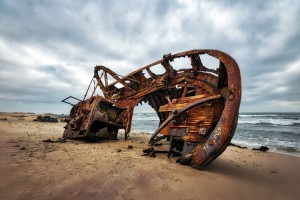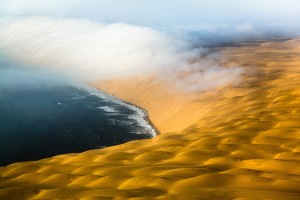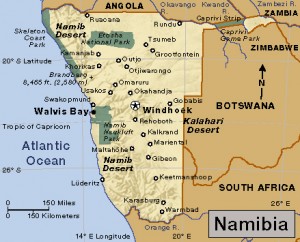Namibia’s Skeleton Coast
Wednesday, October 30th, 2019October 30, 2019
With Halloween tomorrow, World Book takes a peek at the “spooky” Skeleton Coast of Namibia, a country in southwestern Africa. The Skeleton Coast is the western boundary of the northern Namibian part of the Namib Desert. The forbidding area has massive sand dunes and a somewhat otherworldly appearance, but the dunes are not littered with human skeletons. Rather, the area received its name because of the large number of shipwrecks that have occurred there. Many “ship skeletons,” then, lie partially buried in the deep sands of the Skeleton Coast.

The skeletal remains of shipwrecks haunt the Skeleton Coast of Namibia. Credit: © Lukas Bischoff Photograph/Shutterstock
The Skeleton Coast can be particularly hazardous for ocean navigation. The coastline is pounded by heavy surf and its many shallow, rocky outcrops are often shrouded in dense fog. Ships get ensnared in these outcrops, or run aground on sand bars that form, disappear, and reform beneath the waters. Hundreds of shipwrecks dot the landscape, but not all the skeletons are of the naval variety. Large whale bones are often found among the dunes, as are the occasional remains of sailors or diamond miners who met their end among the desolation of the Skeleton Coast.
Diamonds were discovered along the Skeleton Coast in 1904, and the precious crystals are still mined on the beaches. Abandoned diamond settlements add to the area’s eerie Halloween allure, and such ghost towns as Kolmanskop and Elizabeth Bay are alternately covered and revealed by shifting sands.

The Namib Desert’s Skeleton Coast has an unforgiving climate. Some local people call it “the land God made in anger.” Credit: © Radek Borovka, Shutterstock
The Skeleton Coast has a harsh climate. Mists and fog are frequent, but little rain falls. It receives less than 3/4 inch (2 centimeters) of rain a year. Despite this, the protected Skeleton Coast Park is home to a number of animals, including elephants, jackals, springbok, and zebras.
The Namib Desert is the oldest desert in the world. It lies along southern Africa’s west coast, mainly within Namibia. The desert covers more than 31,200 square miles (80,900 square kilometers). It extends from the Orange River in the south to Angola in the north. The Atlantic Ocean is the western limit. The steep slopes known as the Namibian escarpment make up the eastern edge. The desert has some of the highest sand dunes in the world. Some of them rise to more than 1,300 feet (400 meters).



